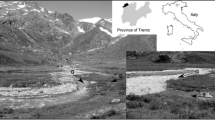Abstract
An investigation on the colonization of artificial substrate baskets by benthos was carried out in the Naro Moru River, a second-order high altitude river in Kenya, from November, 1986 to October, 1987. Simuliidae dominated the colonizing benthos. The mean (±95% CL) maximum colonization time was achieved after 9.63±1.57 days. The highest mean diversity (H′) occurred after 6 days of exposure whilst the highest mean H′maximum, evenness (J′) and species richness (s) were achieved after 10, 8 and 10 days respectively.
The benthos arrival rate (AR) declined exponentially with time. The changes in benthos departure rate (DR) with time was insignificant. Equilibrial state (AR:DR=1.0) was not achieved in the present study.
Similar content being viewed by others
References
Bretschko, G., 1978. Methodenstudie zur Messung der an der Sedimentoberflache lebenden benthischen Bachorganismen. Jb. Biol. Stn. Lunz 1: 36–45.
Bretschko, G. & W. E. Klemens, 1986. Quantitative methods and aspects in the study of the interstitial fauna of running waters. Stygologia 2: 279–316.
Dickson, K. L. & J. Cairns, 1972. The relationship of freshwater macroinvertebrate communities collected by floating artificial substrates to the Macarthur-Wilson equilibrium model. Am. Midl. Nat. 88: 68–75.
Hall, T. J., 1982. Colonizing macroinvertebrates in the upper Mississippi River with a comparison of basket and multiplate samplers. Freshwat. Biol. 12: 211–215.
Hellawell, J. M., 1978. Biological surveillance of rivers — A biological monitoring handbook, 332 pp.
Hurlbert, S. H., 1971. The non-concept of species diversity: a critique and some alternative parameters. Ecology 59: 67–77.
Khalaf, G. & H. Tachet, 1977. La dynamidue de colonisation des substrats artificiels par les macroinvertebres d'un cours d'eau. Ann. Limnol. 13: 169–190.
Khalaf, G. & H. Tachet, 1978. Un probléme d'actualité: revue de travaux en matière d'utilisation des substrats artificiels pour l'échantillonage des macroinvertébrés des eaux courantes. Bull. Ecol. 9: 29–38.
Lake, P. S. & T. J. Doeg, 1985. Macroinvertebrate colonization of stones in two upland southern Australian streams. Hydrobiologia 126: 199–211.
Lock, M. A., 1981. River epilithon — A light and organic energy transducer. In Lock, M. A. & D. D. Williams (eds), Perspectives in running water ecology: 3–40.
Macarthur, R. J. & E. O. Wilson, 1967. The Theory of Island Biogeography. Princeton University Press, Princeton, N.J.
Mathooko, J. M., 1991. Spatial heterogeneity and gradients of sediment organic matter resources and the distribution of macrozoobenthos in an alpine gravel stream — Oberer Seebach (Lunz, Austria). Summer Project, 71 pp.
Mathooko, J. M. & K. M. Mavuti, 1992. Composition and seasonality of benthic invertebrates, and drift in the Naro Morn River, Kenya. Hydrobiologia 232: 47–56.
Meier, P. G., D. L. Penrose & L. Polak, 1979. The rate of colonization by macro-invertebrates on artificial substrate samplers. Freshwat. Biol. 9: 381–392.
Pielou, E. C., 1975. Ecological Diversity. Wiley & Sons, New York.
Roby, K. B., J. D. Newbold & D. C. Ermann, 1978. Effectiveness of an artificial substrate for sampling macroinvertebrates in small streams. Freshwat. Biol. 8: 1–8.
Simberloff, D. S. & E. O. Wilson, 1969. Experimental zoogeography of islands: the colonization of empty islands. Ecology 50: 278–295.
Stauffer, J. R., H. A. Beiles, T. W. Cox, K. L. Dickson & D. E. Simonet, 1976. Colonization of macrobenthic communities on artificial substrates. Rev. Biol. 10: 49–61.
Townsend, C. R., 1989. The patch dynamics concept of stream community ecology. J. N. Am. Benthol. Soc. 8: 36–50.
Townsend, C. R. & A. G. Hildrew, 1976. Field experiments on the drifting, colonization and continuous redistribution of stream benthos. J. anim. Ecol. 45: 759–772.
Ulfstrand, S., 1968. Benthic animal communities in Lapland streams. A field study with particular reference to Ephemeroptera, Plecoptera, Trichoptera and Diptera Simuliidae. Oikos, Suppl. 10: 1–117.
Waters, T. F., 1964. Recolonization of denuded stream bottom areas by drift. Trans. Am. Fish. Soc. 93: 311–315.
Williams, D. D., 1984. The hyporheic zone as a habitat for aquatic insects and associated arthropods. In The Ecology of Aquatic Insects. Resh, V. H. & Rosenberg, D. M. (eds.), 625 pp.
Williams, D. D. & H. B. N. Hynes, 1977. Benthic community development in a new stream. Can. J. Zool. 55: 1071–1076.
Williams, D. D. & A. K. Moore, 1986. Microhabitat selection by a stream dwelling amphipod: a multivariate analysis approach. Freshwat. Biol. 16: 115–122.
Author information
Authors and Affiliations
Rights and permissions
About this article
Cite this article
Mathooko, J.M. Colonization of artificial substrates by benthos in a second-order high altitude river in Kenya. Hydrobiologia 308, 229–234 (1995). https://doi.org/10.1007/BF00006874
Received:
Revised:
Accepted:
Issue Date:
DOI: https://doi.org/10.1007/BF00006874




